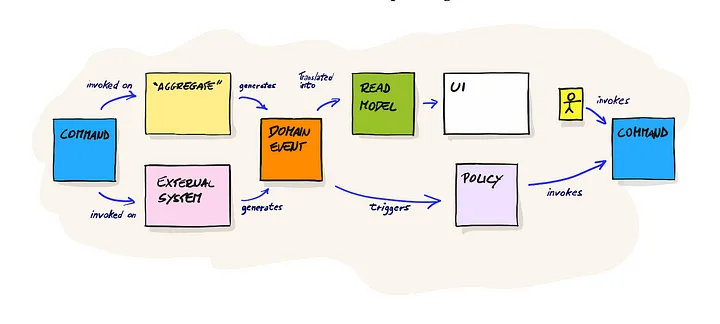Patrón builder en JavaScript para el creado dinámico de elementos en el dom.
Existen muchísimas formas de construir contenido dinámico utilizando JS. Desde el clásico document.createElement hasta los más sofisticados frameworks modernos como react o vue; los cuales indudablemente son una ventaja significativa, facilitando y acelerando la construcción de componentes en vista.
Este post esta dirigido a un ámbito puramente académico y experimental. En donde busco explorar las posibilidades de utilizar los conceptos bases de la programación en situaciones comunes para los desarrolladores.
A continuación presento una pequeña pieza de código JS que permite construir objetos del dom mucho mas fácil:
class Gabo {
constructor(tag) {
this.tag = tag;
this.id = null;
this.class = null;
this.textNode = null;
this.style = null;
this.value = null;
this.contenteditable = null;
this.dataToggle = null;
this.dataPlacement = null;
this.dataParent = null;
this.href = null;
this.ariaExpanded = null;
this.title = null;
this.onClick = null;
this.onChange = null;
this.onkeydown = null;
this.onkeyup = null;
}
setId(id) {
this.id = id;
return this;
}
setClass(clase) {
this.class = clase;
return this;
}
setTextNode(textNode) {
this.textNode = textNode;
return this;
}
setStyle(style) {
this.style = style;
return this;
}
setValue(value) {
this.value = value;
return this;
}
setContentEditable(contenteditable) {
this.contenteditable = contenteditable;
return this;
}
setDataToggle(dataToggle) {
this.dataToggle = dataToggle;
return this;
}
setDataPlacement(dataPlacement) {
this.dataPlacement = dataPlacement;
return this;
}
setDataParent(dataParent) {
this.dataParent = dataParent;
return this;
}
setHref(href) {
this.href = href;
return this;
}
setAriaExpanded(ariaExpanded) {
this.ariaExpanded = ariaExpanded;
return this;
}
setOnClick(onclick) {
this.onClick = onclick;
return this;
}
setOnChange(onchange) {
this.onChange = onchange;
return this;
}
setOnKeyDown(onkeydown) {
this.onkeydown = onkeydown;
return this;
}
setOnKeyUp(onkeyup) {
this.onkeyup = onkeyup;
return this;
}
setTitle(title) {
this.title = title;
return this;
}
build() {
let element = document.createElement(this.tag);
return this.setParameters(element);
}
setParameters(element) {
if (this.id != null) {
element.setAttribute("id", this.id);
}
if (this.class != null) {
element.setAttribute("class", this.class);
}
if (this.textNode != null) {
element.appendChild(document.createTextNode(this.textNode));
}
if (this.contenteditable != null) {
element.setAttribute("contenteditable", this.contenteditable);
}
if (this.dataToggle != null) {
element.setAttribute("data-toggle", this.dataToggle);
}
if (this.dataParent != null) {
element.setAttribute("data-parent", this.dataParent);
}
if (this.href != null) {
element.setAttribute("href", this.href);
}
if (this.ariaExpanded != null) {
element.setAttribute("aria-expanded", this.ariaExpanded);
}
if (this.onClick != null) {
element.setAttribute("onclick", this.onClick);
}
if (this.onChange != null) {
element.setAttribute("onchange", this.onChange);
}
if (this.onkeydown != null) {
element.setAttribute("onkeydown", this.onkeydown);
}
if (this.onkeyup != null) {
element.setAttribute("onkeyup", this.onkeyup);
}
if (this.style != null) {
element.setAttribute("style", this.style);
}
if (this.dataPlacement != null) {
element.setAttribute("data-placement", this.dataPlacement);
}
if (this.title != null) {
element.setAttribute("title", this.title);
}
if (this.value != null) {
element.setAttribute("value", this.value);
}
return element;
}
}
Para comprender como utilizar esta clase, vamos a realizar un ejemplo muy sencillo:
<h1 class="heading-class">My First Heading</h1>
Para replicarlo hacemos lo siguiente
var h1 = new Gabo("h1")
.setClass("heading-class")
.setTextNode("My First Heading")
.build();
Utilizando el patrón builder conseguimos de forma fácil agregar tags a nuestro elemento html. Sin tener que preocuparnos por la implementación. El método build se encarga de tomar los atributos que no están null y agregarlos al elemento.
Hasta el momento, la única desventaja consiste en la enorme cantidad de etiquetas y atributos que existen en html. La única forma de enriquecer esta clase seria ir agregando manualmente las etiquetas que se necesiten. Pero eso no es nada practico. Si alguien consigue mejorar esta clase o consigue construir algo mejor, me encantaría poder ayudar.

Comentarios
Publicar un comentario